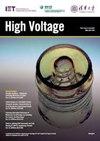Lightning-Induced Overvoltage on Overhead Distribution Line via Hybrid MTL-PEEC Method
IF 4.9
2区 工程技术
Q1 ENGINEERING, ELECTRICAL & ELECTRONIC
引用次数: 0
Abstract
Transient simulation are more economical and adaptable means of studying lightning overvoltage for overhead distribution line system compared to experiments. A hybrid multi-transmission-line (MTL)-partial element equivalent circuit (PEEC) method proposed for lightning-induced electromagnetic pulse (LEMP) simulation is verified using the rocket-triggered experimental results under a more complex line configuration for the first time. This method can improve computational efficiency while ensuring calculation accuracy. The agreement between experimental and simulation results further validates the adaptability and accuracy of the proposed method, which is adopted to calculate the LEMP on the extended double-circuit parallel unequal length line. The effects of various factors, such as the strike-point location, the amplitude and waveform of the lightning current, the line shape and length on the amplitude of overvoltage and pole flashover along the line are discussed. For double-circuit distribution lines, when lightning strikes the ground in front of centre of circuit I, the three-phase voltage waveforms are similar, all of which are negative or bipolar oscillation waves. The closer the lightning strike point is to the line, the greater the amplitude of the lightning current, and the voltage waveform develops towards a bipolar waveform, but the main peak remains negative. As the amplitude of lightning current increases, the maximum lightning-induced voltage amplitude along the line increases. The LEMP caused by the subsequent return-stroke current is always greater than that caused by the first return-stroke current. When the grounding resistance increases, the maximum voltage peak amplitude along the line remains unchanged.基于混合MTL-PEEC方法的架空配电线路雷击过电压分析
暂态仿真是研究架空配电系统雷电过电压的一种比实验更经济、更适用的方法。提出了一种用于雷电感应电磁脉冲(LEMP)仿真的混合多传输在线(MTL)-部分元件等效电路(PEEC)方法,并首次在更复杂的线路配置下使用火箭触发实验结果进行了验证。该方法在保证计算精度的同时,提高了计算效率。实验结果与仿真结果吻合,进一步验证了所提方法的适应性和准确性,并将该方法应用于扩展双回路不等长平行线的LEMP计算。讨论了雷击点的位置、雷击电流的幅值和波形、线路的形状和长度等因素对沿线过电压幅值和极闪络的影响。对于双回配电线路,当雷电击中线路一中心前方的地面时,三相电压波形相似,均为负振荡波或双极振荡波。雷击点越靠近线路,雷击电流幅值越大,电压波形向双极波形发展,但主峰仍为负。随着雷击电流幅值的增大,沿线路的最大雷击电压幅值增大。由随后的返回行程电流引起的LEMP总是大于由第一个返回行程电流引起的LEMP。当接地电阻增大时,沿线路的最大电压峰值幅值保持不变。
本文章由计算机程序翻译,如有差异,请以英文原文为准。
求助全文
约1分钟内获得全文
求助全文
来源期刊

High Voltage
Energy-Energy Engineering and Power Technology
CiteScore
9.60
自引率
27.30%
发文量
97
审稿时长
21 weeks
期刊介绍:
High Voltage aims to attract original research papers and review articles. The scope covers high-voltage power engineering and high voltage applications, including experimental, computational (including simulation and modelling) and theoretical studies, which include:
Electrical Insulation
● Outdoor, indoor, solid, liquid and gas insulation
● Transient voltages and overvoltage protection
● Nano-dielectrics and new insulation materials
● Condition monitoring and maintenance
Discharge and plasmas, pulsed power
● Electrical discharge, plasma generation and applications
● Interactions of plasma with surfaces
● Pulsed power science and technology
High-field effects
● Computation, measurements of Intensive Electromagnetic Field
● Electromagnetic compatibility
● Biomedical effects
● Environmental effects and protection
High Voltage Engineering
● Design problems, testing and measuring techniques
● Equipment development and asset management
● Smart Grid, live line working
● AC/DC power electronics
● UHV power transmission
Special Issues. Call for papers:
Interface Charging Phenomena for Dielectric Materials - https://digital-library.theiet.org/files/HVE_CFP_ICP.pdf
Emerging Materials For High Voltage Applications - https://digital-library.theiet.org/files/HVE_CFP_EMHVA.pdf
 求助内容:
求助内容: 应助结果提醒方式:
应助结果提醒方式:


